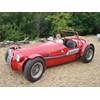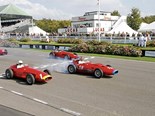Feature: Joy Rainey
.jpg) Revival director Scott Pigdon and event Patron Joy Rainey about to send Paul Faulkner's Williams FW-07 down Ritchie Boulevard
Revival director Scott Pigdon and event Patron Joy Rainey about to send Paul Faulkner's Williams FW-07 down Ritchie Boulevard
.jpg)
.jpg) Joy and mechanic Mark in the 1904 Oldsmobile in the Californian desert
Joy and mechanic Mark in the 1904 Oldsmobile in the Californian desert
.jpg)
.jpg) Royalty Oldsmobile Photo: Geelong Independent
Royalty Oldsmobile Photo: Geelong Independent
.jpg)
.jpg) Joy at Shelsley Walsh in Pilbeam
Joy at Shelsley Walsh in Pilbeam
.jpg)
 Joy and Murray in 1933 Morgan
Joy and Murray in 1933 Morgan

 1936 Alfa Romeo
1936 Alfa Romeo

.jpg) Murray XK120 Speed Trials 1958
Murray XK120 Speed Trials 1958
.jpg)
.jpg) Murray on jhis 80th birthday 1997
Murray on jhis 80th birthday 1997
.jpg)
.jpg) Murray Rainey cornering at Phillip Island
Murray Rainey cornering at Phillip Island
.jpg)
.jpg)
|
|
Revival director Scott Pigdon and event Patron Joy Rainey about to send Paul Faulkner's Williams FW-07 down Ritchie Boulevard
|
.jpg)
|
|
Joy and mechanic Mark in the 1904 Oldsmobile in the Californian desert
|
.jpg)
|
|
Royalty Oldsmobile Photo: Geelong Independent
|
.jpg)
|
|
Joy at Shelsley Walsh in Pilbeam
|

|
|
Joy and Murray in 1933 Morgan
|

|
|
1936 Alfa Romeo
|
.jpg)
|
|
Murray XK120 Speed Trials 1958
|
.jpg)
|
|
Murray on jhis 80th birthday 1997
|
.jpg)
|
|
Murray Rainey cornering at Phillip Island
|
Australian racer Joy Rainey followed her famous father into motorsport and continues to break down motoring boundaries around the world...

|
|
Joy Rainey
|
JOY RAINEY: REVIVAL ROYALTY
By any standards, Geelong-born Joy Rainey is a remarkable woman. Often referred to as a ‘person of restricted growth’ (a tag she reluctantly tolerates) she thought nothing of driving her 110-year-old Oldsmobile 4265km across the US in 2013 and then over 4000km from Adelaide to Darwin in August last year, to aid charities for the disabled in her adopted country of England.
In terms of distance, those are Sunday drives compared to the 16,000km London to Sydney Rally, which she completed in 2004 in a relatively new car – a 1970 Morris Minor – or the 8000km Carrera Sudamericana which she finished in a Jeep Grand Cherokee in 2006.
Joy inherited her determination and love of cars from her father, Murray, a pioneering Australian racer who was instrumental in establishing the Geelong Speed Trials – the forerunner to the Geelong Revival – in 1956. Murray was one of the first Australians to own a Cooper racing car and won three Australian Formula 3 championships (1956, ’57, ’58) in the little motorcycle-engined vehicle, similar to that in which Sir Jack Brabham cut his teeth in the early 50s. It was almost inevitable that Joy would follow her father into motorsport. The seeds were sown early.
"When Dad was racing at Phillip Island he used to let me sit in his Cooper and the mechanics would push it to the start with me steering it; that was a thrill," she smiles. But it was seeing Kiwi Formula 1 star Bruce McLaren racing a kart during the Rainey’s first trip to the UK that really stoked Joy’s competitive fires. When the family returned to Australia and she heard that a kart track had been built outside Geelong, Murray found out just how persistent his 13-year-old daughter could be.
"When I saw Bruce in a kart I thought: ‘Gosh, that would be ideal for me’ and I pestered dad to build me a kart. I won my first and second races and kept winning, so he made a batch of karts he called the Rainey Kart, which used to win a lot in Melbourne. When (1980 F1 World Champion) Alan Jones was a kid, he was leading a kart championship with one race to go but something went wrong, so borrowed his father’s secretary’s Rainey Kart and won the championship. He reckons they were fantastic."
Despite early karting successes, Joy thought her racing career was over after her family relocated to England in 1968. only intended to stay a year," she says. was 21 and wanted to go to Italy and learn Italian, so I didn’t think I’d ever drive again; I’ve always been filled with self-doubt. After being away from Australia for seven years, I needed a holiday and decided to buy a second-hand E-Type Jag, use it in England for a year and then take it to Australia, use it there, then sell it to pay for my holiday. But I loved the E-Type and when I heard about a one-off Jaguar event at the famous Shelsley Walsh hillclimb, I entered. I was petrified but I won the class and that was the beginning of my motorsport career. If I’d been last, it would have been the end of it. But it was the end of my holiday."
Hillclimbing is a major motorsport in Europe and Joy quickly adapted to the discipline of racing up narrow British roads in a series of quicker and quicker cars. "I didn’t want to make the Jaguar into a race car so I bought a Dastle sports racer that my father fitted a 2.0-litre Cosworth FVC engine to. We called it the ‘Murrain’ and it was very competitive and we started breaking records. It was beautiful to drive and I felt 100 per cent confident in it."
Joy upgraded to a more daunting 2.3-litre Pilbeam/Hart single-seater in 1986 and campaigned it until 1992, as well as running a 1936 Alfa Romeo 6C at vintage meetings. Murray had rebuilt the 6C for Joy to race after earlier restoring a 1937 Alfa Romeo 8C for himself. But after Murray passed away in 2003, Joy felt she could no longer race without her father by her side.
"I’m very proud of my father, he was amazing really," she says. "He engineered all my competition cars and people often ask if I’m going to compete again because I still have my Alfa, but it wouldn’t be the same without my father. So I’ll just do demonstrations."
Increasingly drawn to vintage racing, Joy next set her sights on the London to Brighton Veteran Rally – the "world’s longest running motor event" – which celebrates its 119th anniversary this year. The 60-mile (100km) trip from Hyde Park to the seafront in Brighton is for pre-1905 vehicles and Joy first entered in 2001 aboard a borrowed 1901 Clement Voiturette. But after it broke down before the finish she decided to find her own veteran car and sold her Pilbeam to buy a 1904 Oldsmobile Curved Dash Runabout (CDR).
It takes a lot of skill and endurance to drive the Oldsmobile, even for short distances. With tiller steering, a 5.2kW one-cylinder engine and a two-speed transmission, its top speed is only 40km/h, but sitting up high on her ‘horseless carriage’ it seems a lot faster, Joy says.
"Twenty-five miles an hour feels quick, believe me. You have to be strong to steer it because it’s prone to follow camber changes and it doesn’t suit me because on a sharp left I have to lean my whole body out to steer it and on sharp rights I end up in the passenger’s lap because my arms are short. When I first drove it, I thought: ‘Nope, for the first time in my life a mechanical object is defeating me’, but I got used to it."
Success on the London to Brighton led to an even bigger dream: re-enacting the epic 77-day, US coast-to-coast crossing by Lester Whitman and Eugene Hammond in an Oldsmobile CDR in 1903. Joy and companion Mark Riley completed the trip in 33 days, using back roads, not interstates.
"My late partner Trevor Hulks had always wanted to go to America and after I bought the Oldsmobile I found out that the third motorised vehicle to cross the US from coast to coast was an Oldsmobile. Trevor spent a year rebuilding the car and I did the bodywork, but he died of cancer. I didn’t think I could do America by myself, but after a few years it wouldn’t go out of my mind, so I got a group of people together and did it for Trevor." Soon another marathon beckoned, this time in her home country.
"When I finished the American trip I thought: ‘What an amazing car!’ I thought I’d use it on odd occasions in England, do the Brighton Run, and that’s it. But then I was invited to do the Adelaide to Darwin Veteran Rally. I initially thought I couldn’t do it because most of the cars entered were more modern veterans, with two or four cylinders. But I worked out the daily mileages and found they were just a bit longer than my longest days in America, so I entered. There was some opposition because some people thought I wouldn’t be able to keep up, but we did! We didn’t have a backup trailer like most did, just a small motorhome for luggage and spares, but what surprised me was a lot of entrants towed their cars some of the time and unloaded them near the end of each day and I thought: ’Cheating, cheating!’
Then the Revival organisers asked her to bring the Olds to Geelong. "Three days before the end of the Darwin run in that amazing car – they’re not meant to do long distances – I just felt that I wanted to take it to Geelong," Joy explains. Although she is Patron of the Revival and remembers going to the Speed Trials as a child, Joy had never competed in Geelong, although she did do a couple laps back in 1989.
"The Trials organisers flew Dad’s second Cooper out in 1989 for him to drive and I did two demonstration runs in it," she recalls. "I was absolutely thrilled to be in my father’s car, in the event he helped to start, on a course I’d seen all my life but had never driven on." And now Joy has ‘raced’ her beloved Olds down Ritchie Boulevard too, inspiring all who watched her. After driving virtually all points of the atlas, was this homecoming a final bookend to her exploits behind the tiller? Not a bit of it. Not even close.
Unique Cars magazine Value Guides
Sell your car for free right here
Get your monthly fix of news, reviews and stories on the greatest cars and minds in the automotive world.
Subscribe

.jpg)













